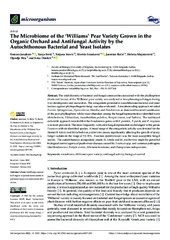Приказ основних података о документу
The Microbiome of the 'Williams' Pear Variety Grown in the Organic Orchard and Antifungal Activity by the Autochthonous Bacterial and Yeast Isolates
| dc.creator | Jankiev, Tamara | |
| dc.creator | Berić, Tanja | |
| dc.creator | Stević, Tatjana | |
| dc.creator | Stanković, Slaviša | |
| dc.creator | Bačić, Jasmina | |
| dc.creator | Majstorović, Helena | |
| dc.creator | Fira, Đorđe | |
| dc.creator | Dimkić, Ivica | |
| dc.date.accessioned | 2023-12-07T18:05:21Z | |
| dc.date.available | 2023-12-07T18:05:21Z | |
| dc.date.issued | 2022 | |
| dc.identifier.issn | 2076-2607 | |
| dc.identifier.uri | https://enauka.gov.rs/handle/123456789/779167 | |
| dc.identifier.uri | https://intam.institut-tamis.rs/handle/123456789/218 | |
| dc.identifier.uri | https://plantarum.izbis.bg.ac.rs/handle/123456789/1190 | |
| dc.description.abstract | The total diversity of bacterial and fungal communities associated with the phyllosphere (fruits and leaves) of the 'Williams' pear variety was analyzed in two phenological stages during fruit development and maturation. The antagonistic potential of autochthonous bacterial and yeast isolates against phytopathogenic fungi was also evaluated. A metabarcoding approach revealed Pantoea, Sphingomonas, Hymenobacter, Massilia, and Pseudomonas as dominant bacterial constituents of the pear phyllosphere, whilst most abundant among the fungal representatives identified were Metschnikowia, Filobasidium, Aureobasidium pullulans, Botrytis cinerea, and Taphrina. The traditional culturable approach revealed that the Pseudomonas genus with P. graminis, P. putida, and P. congelans was most prevalent. The most frequently cultivated fungal representatives belonged to the genus Fusarium with six identified species. A broad range of the antagonistic activity was detected for the Hannaella luteola and Metschnikowia pulcherrima yeasts, significantly affecting the growth of many fungal isolates in the range of 53-70%. Fusarium sporotrichioides was the most susceptible fungal isolate. The autochthonous antagonistic yeasts H. luteola and M. pulcherrima might be powerful biological control agents of postharvest diseases caused by Fusarium spp. and common pathogens like Monilinia laxa, Botrytis cinerea, Alternaria tenuissima, and Cladosporium cladosporioides. | sr |
| dc.language.iso | en | sr |
| dc.publisher | MDPI | sr |
| dc.relation | Ministry of Education, Science and Technological Development of Serbia, Collaborative Research Programme (CRP)-ICGEB Research Grants Programme | sr |
| dc.relation | Diaspora: Knowledge Sharing Vouchers of the Science Fund of the Republic of Serbia [451-03-68/2022-14/200178, CRP/SRB19-02, OIS-AIR 77, BIOCTA 6436066] | sr |
| dc.relation | INTERREG ADRION OIS-AIR (Open Innovation System of the Adriatic-Ionian Region) proof-ofconcept project | sr |
| dc.rights | openAccess | sr |
| dc.rights.uri | https://creativecommons.org/licenses/by/4.0/ | |
| dc.source | Microorganisms | sr |
| dc.subject | Williams's pear variety | sr |
| dc.subject | microbiome | sr |
| dc.subject | biological control | sr |
| dc.subject | antifungal activity | sr |
| dc.title | The Microbiome of the 'Williams' Pear Variety Grown in the Organic Orchard and Antifungal Activity by the Autochthonous Bacterial and Yeast Isolates | sr |
| dc.type | article | sr |
| dc.rights.license | BY | sr |
| dc.citation.issue | 7 | |
| dc.citation.spage | 1282 | |
| dc.citation.volume | 10 | |
| dc.type.version | publishedVersion | sr |
| dc.identifier.doi | 10.3390/microorganisms10071282 | |
| dc.identifier.fulltext | http://plantarum.izbis.bg.ac.rs/bitstream/id/3695/214.pdf | |
| dc.identifier.pmid | 35889000 | |
| dc.identifier.scopus | 2-s2.0-85132548491 | |
| dc.identifier.wos | 000833635200001 |


